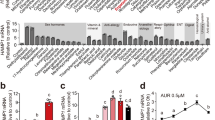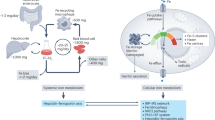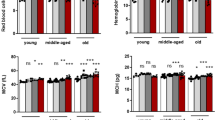Abstract
Iron is critical for life but toxic in excess because of iron-catalysed formation of pro-oxidants that cause tissue damage in a range of disorders. The transcription factor nuclear factor erythroid 2-related factor 2 (Nrf2) orchestrates cell-intrinsic protective antioxidant responses, while the peptide hormone hepcidin maintains systemic iron homoeostasis, but is pathophysiologically decreased in haemochromatosis and β-thalassaemia. Here, we show that Nrf2 is activated by iron-induced, mitochondria-derived pro-oxidants and drives bone morphogenetic protein 6 (Bmp6) expression in liver sinusoidal endothelial cells, which in turn increases hepcidin synthesis by neighbouring hepatocytes. In Nrf2 knockout mice, the Bmp6–hepcidin response to oral and parenteral iron is impaired, and iron accumulation and hepatic damage are increased. Pharmacological activation of Nrf2 stimulates the Bmp6–hepcidin axis, improving iron homoeostasis in haemochromatosis and counteracting the inhibition of Bmp6 by erythroferrone in β-thalassaemia. We propose that Nrf2 links cellular sensing of excess toxic iron to the control of systemic iron homoeostasis and antioxidant responses, and may be a therapeutic target for iron-associated disorders.
This is a preview of subscription content, access via your institution
Access options
Access Nature and 54 other Nature Portfolio journals
Get Nature+, our best-value online-access subscription
$29.99 / 30 days
cancel any time
Subscribe to this journal
Receive 12 digital issues and online access to articles
$119.00 per year
only $9.92 per issue
Buy this article
- Purchase on Springer Link
- Instant access to full article PDF
Prices may be subject to local taxes which are calculated during checkout






Similar content being viewed by others
Data availability
The datasets generated and/or analysed during the current study are available from the corresponding author upon reasonable request.
References
Muckenthaler, M. U., Rivella, S., Hentze, M. W. & Galy, B. A red carpet for iron Metabolism. Cell 168, 344–361 (2017).
Ganz, T. Systemic iron homeostasis. Physiol. Rev. 93, 1721–1741 (2013).
Nemeth, E. et al. Hepcidin regulates cellular iron efflux by binding to ferroportin and inducing its internalization. Science 306, 2090–2093 (2004).
Pietrangelo, A. Genetics, genetic testing, and management of hemochromatosis: 15 years since hepcidin. Gastroenterology 149, 1240–1251.e4 (2015).
Gupta, R., Musallam, K. M., Taher, A. T. & Rivella, S. Ineffective erythropoiesis: anemia and iron overload. Hematol. Oncol. Clin. North Am. 32, 213–221 (2018).
Kautz, L. et al. Iron regulates phosphorylation of Smad1/5/8 and gene expression of Bmp6, Smad7, Id1, and Atoh8 in the mouse liver. Blood 112, 1503–1509 (2008).
Andriopoulos, B.Jr. et al. BMP6 is a key endogenous regulator of hepcidin expression and iron metabolism. Nat. Genet. 41, 482–487 (2009).
Meynard, D. et al. Lack of the bone morphogenetic protein BMP6 induces massive iron overload. Nat. Genet. 41, 478–481 (2009).
Canali, S. et al. Endothelial cells produce bone morphogenetic protein 6 required for iron homeostasis in mice. Blood 129, 405–414 (2017).
Koskenkorva-Frank, T. S., Weiss, G., Koppenol, W. H. & Burckhardt, S. The complex interplay of iron metabolism, reactive oxygen species, and reactive nitrogen species: insights into the potential of various iron therapies to induce oxidative and nitrosative stress. Free Radic. Biol. Med. 65, 1174–1194 (2013).
Hershko, C. Pathogenesis and management of iron toxicity in thalassemia. Ann. N. Y. Acad. Sci. 1202, 1–9 (2010).
Suzuki, T. & Yamamoto, M. Molecular basis of the Keap1–Nrf2 system.Free Radic. Biol. Med. 88, 93–100 (2015).
Kobayashi, A. et al. Oxidative and electrophilic stresses activate Nrf2 through inhibition of ubiquitination activity of Keap1. Mol. Cell. Biol. 26, 221–229 (2006).
Igarashi, K. & Watanabe-Matsui, M. Wearing red for signaling: the heme-bach axis in heme metabolism, oxidative stress response and iron immunology.Tohoku J. Exp. Med. 232, 229–253 (2014).
Kautz, L. et al. BMP/Smad signaling is not enhanced in Hfe-deficient mice despite increased Bmp6 expression. Blood 114, 2515–2520 (2009).
Ryan, J. D., Ryan, E., Fabre, A., Lawless, M. W. & Crowe, J. Defective bone morphogenic protein signaling underlies hepcidin deficiency in HFE hereditary hemochromatosis. Hepatology 52, 1266–1273 (2010).
Moon, M. S. et al. Elevated hepatic iron activates NF-E2-related factor 2-regulated pathway in a dietary iron overload mouse model. Toxicol. Sci. 129, 74–85 (2012).
Silva-Gomes, S. et al. Transcription factor NRF2 protects mice against dietary iron-induced liver injury by preventing hepatocytic cell death. J. Hepatol. 60, 354–361 (2014).
Armitage, A. E. Induced disruption of the iron-regulatory hormone hepcidin inhibits acute inflammatory hypoferraemia.J. Innate Immun. 8, 517–528 (2016).
Liby, K. et al. The synthetic triterpenoids, CDDO and CDDO-imidazolide, are potent inducers of heme oxygenase-1 and Nrf2/ARE signaling. Cancer Res. 65, 4789–4798 (2005).
Cleasby, A. et al. Structure of the BTB domain of Keap1 and its interaction with the triterpenoid antagonist CDDO. PLoS ONE 9, e98896 (2014).
Uruno, A. et al. Nrf2-mediated regulation of skeletal muscle glycogen metabolism. Mol. Cell. Biol. 36, 1655–1672 (2016).
Yamamoto, T. et al. Predictive base substitution rules that determine the binding and transcriptional specificity of Maf recognition elements. Genes Cells 11, 575–591 (2006).
Reichard, J. F., Motz, G. T. & Puga, A. Heme oxygenase-1 induction by NRF2 requires inactivation of the transcriptional repressor BACH1. Nucleic Acids Res. 35, 7074–7086 (2007).
Mills, E. L. et al. Itaconate is an anti-inflammatory metabolite that activates Nrf2 via alkylation of KEAP1. Nature 556, 113–117 (2018).
Urrutia, P. J., Mena, N. P. & Núñez, M. T. The interplay between iron accumulation, mitochondrial dysfunction, and inflammation during the execution step of neurodegenerative disorders. Front. Pharmacol. 5, 38 (2014).
Huang, H. et al. Iron-induced generation of mitochondrial ROS depends on AMPK activity. Biometals 30, 623–628 (2017).
Liang, H. L. et al. Partial attenuation of cytotoxicity and apoptosis by SOD1 in ischemic renal epithelial cells. Apoptosis 14, 1176–1189 (2009).
Robb, E. L. et al. Selective superoxide generation within mitochondria by the targeted redox cycler MitoParaquat. Free Radic. Biol. Med. 89, 883–894 (2015).
Higdon, A., Diers, A. R., Oh, J. Y., Landar, A. & Darley-Usmar, V. M. Cell signalling by reactive lipid species: new concepts and molecular mechanisms. Biochem. J. 442, 453–464 (2012).
Fazakerley, D. J. et al. Mitochondrial oxidative stress causes insulin resistance without disrupting oxidative phosphorylation. J. Biol. Chem. 293, 7315–7328 (2018).
Yanagawa, T. et al. Nrf2 deficiency causes tooth decolourization due to iron transport disorder in enamel organ. Genes Cells 9, 641–651 (2004).
Marro, S. et al. Heme controlsferroportin1 (FPN1) transcription involving Bach1, Nrf2 and a MARE/ARE sequence motif at position −7007 of the FPN1 promoter. Haematologica 95, 1261–1268 (2010).
Jenkitkasemwong, S. et al. SLC39A14 is required for the development of hepatocellular iron overload in murine models of hereditary hemochromatosis. Cell Metab. 22, 138–150 (2015).
Lebeau, A. et al. Long-term sequelae of HFE deletion in C57BL/6 × 129/O1a mice, an animal model for hereditary haemochromatosis. Eur. J. Clin. Invest. 32, 603–612 (2002).
Duarte, T. L. et al. Genetic disruption of NRF2 promotes the development of necroinflammation and liver fibrosis in a mouse model of HFE-hereditary hemochromatosis. Redox Biol. 11, 157–169 (2017).
Koch, P. S. et al. Angiocrine Bmp2 signaling in murine liver controls normal iron homeostasis. Blood 129, 415–419 (2017).
Köhler, U. A. et al. Activated Nrf2 impairs liver regeneration in mice by activation of genes involved in cell-cycle control and apoptosis. Hepatology 60, 670–678 (2014).
Kautz, L. et al. Identification of erythroferrone as an erythroid regulator of iron metabolism. Nat. Genet. 46, 678–684 (2014).
Arezes, J. et al. Erythroferrone inhibits the induction of hepcidin by BMP6. Blood 132, 1473–1477 (2018).
Yang, B. et al. A mouse model for beta 0-thalassemia. Proc. Natl Acad. Sci. USA 92, 11608–11612 (1995).
Wilkinson, N. & Pantopoulos, K. The IRP/IRE system in vivo: insights from mouse models. Front. Pharmacol. 5, 176 (2014).
Sanchez, M. et al. Iron regulatory protein-1 and -2: transcriptome-wide definition of binding mRNAs and shaping of the cellular proteome by iron regulatory proteins. Blood 118, e168–e179 (2011).
Hentze, M. W., Muckenthaler, M. U., Galy, B. & Camaschella, C. Two to tango: regulation of mammalian iron metabolism. Cell 142, 24–38 (2010).
Bhandari, S., Pereira, D. I. A., Chappell, H. F. & Drakesmith, H. Intravenous irons: from basic science to clinical practice. Pharmaceuticals (Basel) 11, E82 (2018).
Brittenham, G. M. et al. Circulating non-transferrin-bound iron after oral administration of supplemental and fortification doses of iron to healthy women: a randomized study. Am. J. Clin. Nutr. 100, 813–820 (2014).
Corradini, E. et al. BMP6 treatment compensates for the molecular defect and ameliorates hemochromatosis in Hfe knockout mice. Gastroenterology 139, 1721–1729 (2010).
Casu, C. et al. Minihepcidin peptides as disease modifiers in mice affected by β-thalassemia and polycythemia vera. Blood 128, 265–276 (2016).
Bollong, M. J. et al. A metabolite-derived protein modification integrates glycolysis with KEAP1-NRF2 signalling. Nature 562, 600–604 (2018).
Dodson, M. et al. Modulating NRF2 in disease: timing is everything.Annu. Rev. Pharmacol. Toxicol. 59, 555–575 (2019).
Itoh, K. et al. An Nrf2/small Maf heterodimer mediates the induction of phase II detoxifying enzyme genes through antioxidant response elements. Biochem. Biophys. Res. Commun. 236, 313–322 (1997).
Bahram, S. et al. Experimental hemochromatosis due to MHC class I HFE deficiency: immune status and iron metabolism. Proc. Natl Acad. Sci. USA 96, 13312–13317 (1999).
Lesbordes-Brion, J. C. et al. Targeted disruption of the hepcidin 1 gene results in severe hemochromatosis. Blood 108, 1402–1405 (2006).
Matsumura, T. et al. Establishment of an immortalized human-liver endothelial cell line with SV40T and hTERT. Transplantation 77, 1357–1365 (2004).
Malhotra, D. et al. Global mapping of binding sites for Nrf2 identifies novel targets in cell survival response through ChIP-Seq profiling and network analysis. Nucleic Acids Res. 38, 5718–5734 (2010).
Acknowledgements
The authors thank the staff of the University of Oxford Department of Biomedical Services for animal husbandry, M. Nairz (Medical University of Innsbruck) for assistance with flow cytometry and A. Townsend (Weatherall Institute of Molecular Medicine) for helpful advice and discussions. This work was supported by the UK Medical Research Council (MRC Human Immunology Unit core funding to H.D., award no. MC_UU_12010/10) and Radcliffe Department of Medicine (RDM Scholars Program to P.J.L.). The work conducted at the Instituto de Biologia Molecular e Celular was supported by FEDER funds through COMPETE and by Portuguese funds through Fundação para a Ciência e Tecnologia (grant nos. PTDC/BIM-MET/0739/2012 and SFRH/BPD/108207/2015 to T.L.D.), and the Norte 2020 Portugal Regional Operational Programme (grant no. Norte-01-0145-FEDER-000012). J.L.B. was supported by the National Institutes of Health (grant no. RO1-DK087727) and Massachusetts General Hospital (Howard Goodman Award). Work in M.P.M.’s lab is supported by the Medical Research Council UK (grant no. MC_U105663142) and by a Wellcome Trust Investigator award (no. 110159/Z/15/Z). A.M.H., D.G.S. and P.P. were funded by grants from the Canadian Institutes of Health Research (grant nos. MOP-14100 and MOP-126064).
Author information
Authors and Affiliations
Contributions
P.J.L., T.L.D., C.B.W., D.G.S., P.P., A.E.A., S.R.P. and H.D. designed the research. P.J.L., T.L.D., A.E.A., J.A., H.M., D.G.S., A.H., S.W., S.R.P., J.R.H., A.G.S., A.L.B., A.S.G., A.M., E.S., C.Y.W. and J.L.B. collected the data. P.J.L., H.D., T.L.D., D.G.S., P.P., P.K., A.E.A., S.R.P., E.S., R.C.H., M.P.M., C.Y.W., J.L.B. and G.P. analysed and interpreted the data. P.J.L. and H.D. wrote the manuscript.
Corresponding author
Ethics declarations
Competing interests
The authors declare no competing interests.
Additional information
Publisher’s note: Springer Nature remains neutral with regard to jurisdictional claims in published maps and institutional affiliations.
Supplementary Information
Supplementary Information
Supplementary Figs. 1–10 and Supplementary Tables 1–4
Rights and permissions
About this article
Cite this article
Lim, P.J., Duarte, T.L., Arezes, J. et al. Nrf2 controls iron homoeostasis in haemochromatosis and thalassaemia via Bmp6 and hepcidin. Nat Metab 1, 519–531 (2019). https://doi.org/10.1038/s42255-019-0063-6
Received:
Accepted:
Published:
Issue Date:
DOI: https://doi.org/10.1038/s42255-019-0063-6
This article is cited by
-
Mechanisms controlling cellular and systemic iron homeostasis
Nature Reviews Molecular Cell Biology (2024)
-
Iron overload induces dysplastic erythropoiesis and features of myelodysplasia in Nrf2-deficient mice
Leukemia (2024)
-
Nrf2 activation does not affect adenoma development in a mouse model of colorectal cancer
Communications Biology (2021)
-
Radical sensing keeps noxious iron at bay
Nature Metabolism (2019)



